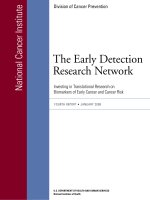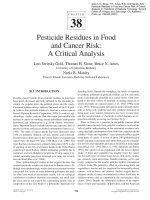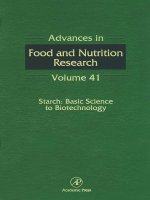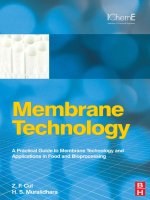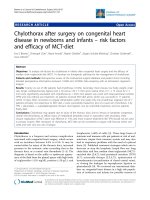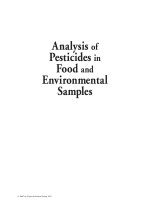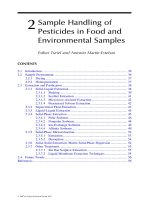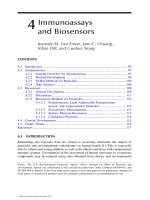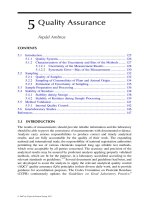Toxicants residue in food and cancer risk: Captan (C9H8Cl3NO2S)
Bạn đang xem bản rút gọn của tài liệu. Xem và tải ngay bản đầy đủ của tài liệu tại đây (443.59 KB, 17 trang )
Toxicants residue in food and cancer
risk: Captan (C9H8Cl3NO2S)
Environmental Toxicology
Group 14
5/28/16
content
Captan
Residue in food
Exposure
D-R, exposure
Acute toxicity
Chronic toxicity
Human health effects
Distribution and excretion
Cancer risk
Characterization
Toxicity on animal
Toxicity to human
Cancer risk
Notes
Captan introduction
1,2,3,6-tetrahydro-N- (trichloromethylthio) phthalimide
C9H8Cl3NO2S
A white solid
agricultural fungicide
Target pests:
numerous fungi and
microbial
Residue in food
Captan is highly recommended for preventing and controlling fungal diseases on:
Fruits
Apples, Grapes, Peaches and Strawberries
Vegetables
Seed Treatment Only
Apple scab
Bulbs
Preplan Treatment - Gladioli and Tuberous Begonias
Lawns and turf
Ornamentals
Azaleas, Carnations, Chrysanthemums, and Roses
Oil farm
Peach scab
Exposure
Pathways
Food
Air
Water
Routs
Inhalation
Ingestion
Eyes contact
Skin contact
Distribution and Excretion
Distribution
Administered to rats orally, activity was recovered as follows:
51.8% urine
22.8% expired air
15.9% feces
0.6% tissues
Excretion
first 24 hours, more than 90% excreted in the urine and feces,
during the next two days almost all the rest was excreted
Only 0.01-0.05% was deposited in the organs
Dose and response, exposure
Acute toxicity
Chronic toxicity
Human health effects
Acute toxicity
The mechanism of action may involve the degradation of captan into the short-lived thiophosgene, which is a highly reactive with thiols and
other functional groups.
Test
Results
Oral LD50 - rat
LD50 = 9 g/kg (M)
Dermal LD50 – rat
LD50 > 2 g/kg
Inhalation LC50 – rat
Eye Irritation – rabbit
LC50 = 0.72 mg/L (M)
LC50 = 0.87 mg/L (F)
Irreversible corneal opacity
at 21 days in unwashed eyes
Dermal Irritation -rabbit
Not an irritant at 3 days
Dermal Sensitization -guinea pig
Moderate skin sensitizer
Data extract from Captan technical fact sheet, US national pesticide information
Chronic toxicity
Reproduction
In a three-generation rat reproduction study:
at 1000 mg/kg diet (50 (mg/kg)/day)
lowered lactation in 3
rd
generation (only
effects)
at 500 mg/kg (5 (mg/kg)/day) no effects
Teratogenicity
Rabbit: No malformed fetuses were observed from rabbits given up to 75 mg/kg of captan orally on days 6-18 of gestation.
Monkey: no fetal malformations from monkeys given up to 75 mg/kg on days 21-34 of gestation.
Human health effects
Acceptable daily intake for man: 0 - 0.1 mg/kg
Signs of Toxicity – Humans:
Individuals working with captan or in fields where captan was applied reported eye and skin irritation.
Investigators conducted patch tests with 0.1 to 1.0% captan which they placed on the upper backs of 279 to 442 individuals who were currently, one
time, or never employed in agriculture:
Out of the 442 people tested,
13 individuals at the highest dose experienced irritant reactions.
17 experienced allergic reactions.
Human health effects
Case report
acute
17 years old woman (suicide)
7.5 g of Captan
after 3 hours: headache, nausea, weakness, numbness of upper limbs,
and substernal pain
chronic
A 73-yr old retired fruit grower
Workers
spraying operations using captan
captan in air (5 mg/m3)
(high concentration)
persistent erythema, itching, & desquamation of the face & backs of
hands
eye irritation including burning, itching and tearing
Cancer risk
The U.S. EPA has assigned captan a carcinogenicity classification of B2, probable human carcinogen
(B2: Sufficient evidence of carcinogenicity from animal studies with inadequate or no data from epidemiologic studies in
humans.)
From PAN pesticide
database
cancer risk
Test
Charles River CD rats were fed 25 to 250 mg/kg/day captan for 2 years.
Males
- exhibited hepatocellular hypertrophy and significant trends of adenomas and carcinomas in the kidney at 100 mg/kg/day.
- increased relative organ weight for heart, brain, liver, and thyroid/parathyroid.
Both sexes
- showed an increased relative kidney weight and a decreased body weight.
- The lowest observable effects level (LOEL) was determined to be 100 mg/kg/day
cancer risk
Captan residues on apples, cantaloupe, cucumbers, grapefruit, lemons, lettuce, oranges, squash, strawberries, and spinach is substantially
reduced by washing and almost non-detectable after peeling.
Captan residues in celery, cucumbers, squash, and spinach is almost non-detectable after cooking.
Residential Exposure Activity
Primary handler - Mixing/loading/applying
wettable powders to fruit trees
Residential
Food
Aggregate
DWLOC cancer
Cancer
Cancer
Food and
ppb
Risk
Risk
Residential
6.5x10
Secondary handler - Painting with a brush
8.5x10
Post application - Ornamentals
4.2x10
-7
-8
-8
1.3x10
1.3x10
1.3x10
-7
-7
-7
7.8x10
2.2x10
1.7x10
-7
-7
-7
3.2
11
12
Aggregate Cancer Risks for Captan, EPA
DWLOC: drinking water levels of comparison
Characterization
Toxicity on animal
Toxicity to human
low in toxicity if eaten by
low in toxicity if breathed in
skin irritation
allergic reactions
low in toxicity if contacted with skin
highly toxic to the eyes
Decrease immune function with large amount used
Cancer risk
Rats and mice developed various types of cancers
B2 category to human by US EPA
Notes within captan residues in food
Many fruits and vegetables may contain captan residues but it can be easily washed.
Cooking eliminates captan residues.
Do the following if you experience any:
Route of Exposure
Symptoms
Inhalation
First Aid
Fresh air rest. Refer for medical attention.
Skin
MAY BE ABSORBED! Redness
Eye
Redness. Pain. Blurred vision
Ingestion
Diarrhea. Vomiting.
Remove contaminated clothes. Rinse and then wash skin with water and soap. Refer for
edictal attention.
First rinse with plenty of water for several minutes (remove contact lenses if easily possible)
then take to a doctor.
Rinse mouth. Refer for medical attention.
Thank you
We welcome any question or comment.
